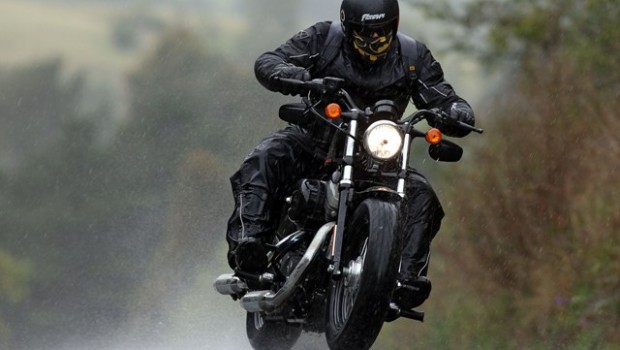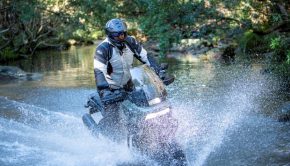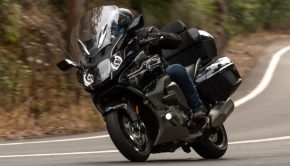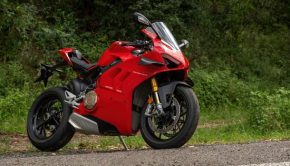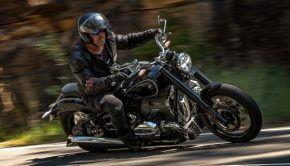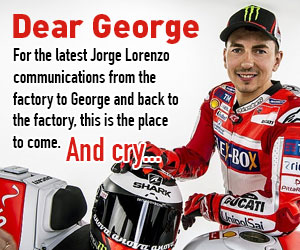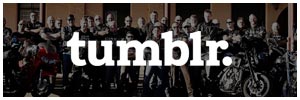2011 HARLEY LAUNCH & THE RISE OF THE SPORTSTERS
It was with a glad heart and a backpack full of wet weather gear that I rode my long-term Victory 8-Ball to the 2011 Harley-Davidson launch at Trivett Harley-Davidson.
For that is how I roll.
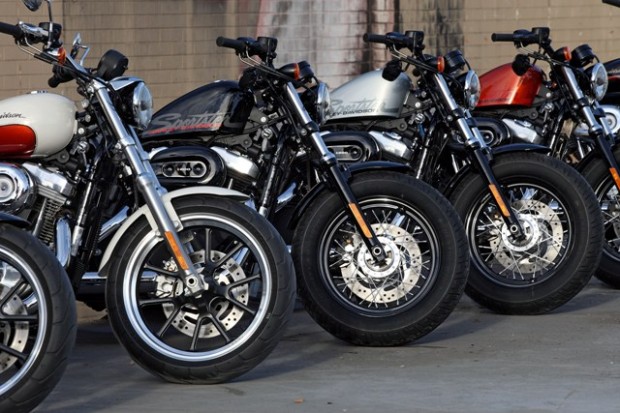
My rolling aside, it was pleasing to catch-up with some of my peers, and the usual Harley crew of Chris, Bob and Marcus. These blokes do an awesome and usually thankless task of shepherding utterly worthless motorcycle journos around the country and through a brace of photo-stops for the lens of Lou Martin.
With the Victory safely entombed within the bowels of Trivett’s very impressive showroom, we were treated to a brief presentation of what’s new in the Harley zoo this year. Which is quite a bit, actually, despite the Global Financial Crisis raping the buggery out of everyone’s fiscal happiness.
So this is what you can expect from Harley in 2011…
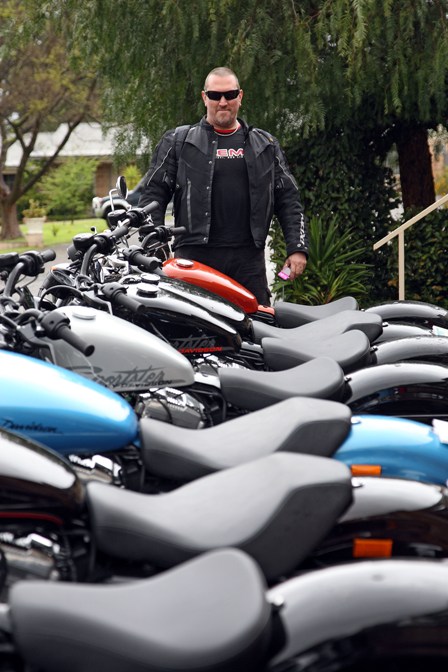
Here at BIKE ME! we’re developing the 7-assed Boris, who will be able to ride all of these at once. Tremble, bitches.
The big tourers all get 103-cube (1690cc) donks, producing102 ft. lbs. of torque at 3500 rpm (which is10 per cent more than the Twin Cam 96-inch motors). The other stuff you may already be familiar with, but for the spec-heads it’s a 9.6:1 compression ratio, with a 3.875-inch bore and a 4.38-inch stroke, with Electronic Sequential Port Fuel Injection. So it’s all rather familiar. The tourers also get new seats – they’re a bit narrower, but with a deeper bucket and new foam, which Harley believes will be more comfortable and offer riders more confidence when they’re paddling the beasts around at low speed. As always, Harley evolves its models slowly, but surely.
The Road Glide Ultra, a model not imported to Oz in many years, will also appear to test the market’s acceptance of one of the better tourers in the world – and I hope to get a spin on it at some stage later this year. ABS will now be standard on all touring, Softail and V-Rod models – which is not surprising given the level of acceptance ABS has achieved within the market. Not five years ago the dinosaurs among us, me included, were all decrying it as the work of the devil. Now it is so ubiquitous, it hardly rates a mention.
Harley’s CVO range (they’re the big-dollar, super-trick models) is back after a short hiatus on the sidelines, and in 2011, you’ll see a CVO Softail Convertible, a Street Glide and an Electra Glide Ultra Classic all pimped to the heavens. The 2011 CVOs differ from the normal Harleys in several significant ways, i.e.
- 110-cubic-inc engine
- 8GB Ipod Nano (except on the Ultra)
- 19-inch Agitator front wheel on the Street Glide
- Premium audio 100W/channel on the Street Glide
- Keyless ignition on the Softail Convertible
- Heated seat on the Ultra
- Remote control power locks on the Ultra Tour package
I have ridden a few CVOs and they really are something altogether special. Harley has also “realigned” the pricing on some of them, dropping the cost of CVO models by up to $12,995.
But the biggest news is the startling rise of the Sportsters and the coming of what I reckon is one of the toughest-looking bikes on the market, and certainly one of the most aesthetically pleasing bikes Harley has produced in ages, the Sportster 48.
Last year’s Iron Sportster model outsold the Fatboy and the FXST in Kiwiland and was the 8th biggest-selling road bike in Australia. The entire Sportster range (dubbed XL) represents 22 per cent of Harley’s overall sales. The new 48 is the fastest-selling model in the USA, which is hugely revealing.

The Sportster SuperLow. A paltry $11,495.
Let us first consider Harley’s entry-level bike, the Sportster SuperLow. It costs a paltry $11,495 (plus ORC, while the 48 is $14,995 plus ORC) and has been substantially re-jigged in lots of key areas, addressing what Harley told us were the concerns of potential buyers looking to get themselves onto a Harley. The fuel range has been increased (17-litre tank), the suspension travel has been also been increased, and there’s been some work done to the seat and the overall steering geometry. It is wider lock-to-lock in the steering range, there’s a lighter and smaller diameter front wheel, the drive sprocket’s been matched to the rear tyre diameter to allow for a cleaner get-away from a standstill, and it now boasts beaut Michelin radials and pre-load adjustable rear shocks.
The end result, Harley believes, is a very user-friendly bike that steers better than any previous Sporty and is especially gentle and loving at low speeds, which is where a lot of beginners get into trouble and tumble to the ground…, um, to my admittedly immense delight. But I am a cruel and shameless swine in that regard.
Has Harley succeeded in is mission to make a friendlier Sporty? Yes. Without a doubt. The SuperLow was indeed a sweet-steering, easy-peasy-to-ride bike. I found the riding position a little “locked-in”, as it were, but newbies don’t tend to mind that as much as more experienced riders, and I am rather meaty and lengthy in many ways. Also gone are the wretched buckhorn handlebars and the new, wider units are much better in every way. It’s not a fire-breather, but it’s got more than enough go for beginners and nervous people.
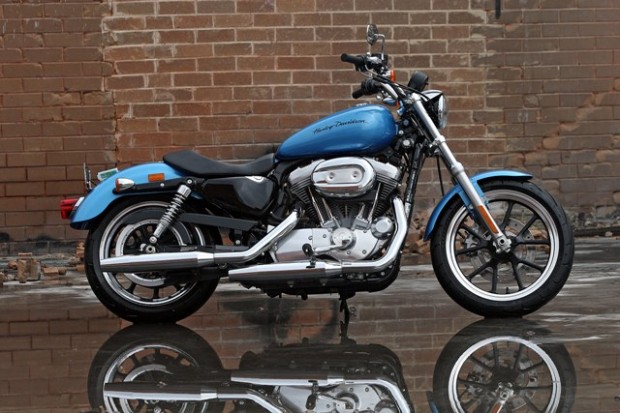
It’s gentle and loving at low speeds. When it’s stopped, you’ll probably get lucky.
Which now brings me to the utterly gorgeous 48 – so named because the eight-litre peanut tank on the current bike first appeared in 1948. And practicality aside, it looks sensational when combined with the fat front wheel (which is the same diameter as the back wheel) – giving the bike an amazing retro-bobber look.
I was a little disappointed the bike doesn’t have the 1200 motor from the altogether marvellous XR1200, and runs a far less angry version…well, I was disappointed until I rode it. Then some things became clearer than they were when I was rubbing my man-parts all over it in the showroom.
So why does the bike work so well on an aesthetic level? In my view there are two main things going on here. First is the fat, high-profile front tyre. It’s just so ’50s. Second, it’s the stylistic genius of inverting the mirrors so they sit under the handlebars, thus cleaning up the profile of the bike beyond measure. It’s such a simple fix, yet so effective. They take a bit of getting used to down there, in that you need to look for them at first, but after an hour or so, it becomes automatic.
During the presentation I was introduced to James Sadauckas, Harley’s Vehicle Dynamics Senior Project Engineer. Except he ain’t so senior-looking, did his PhD in why motorcycles go around corners the way they do, and clearly has a brain the size of a small planet. He was smarter than everyone in that room combined and I hope he forgave me when my eyes began to glaze over a little when he began to speak of oscillating forces.
It was James’ job to make sure these bikes act like motorcycles when you lace them into a bend. Now if you’ve ridden Harleys before, you’ll understand they don’t quite have the same handling characteristics that sportsbikes do. Nor should they. They tickle different glands, and thus behave differently when those glands are being tickled. James told us he spent a lot of his immense brainpower making the SuperLow and the 48 behave in bends. I had no reason to doubt him and at the end of a very wet day of riding, I think he did a remarkable job.
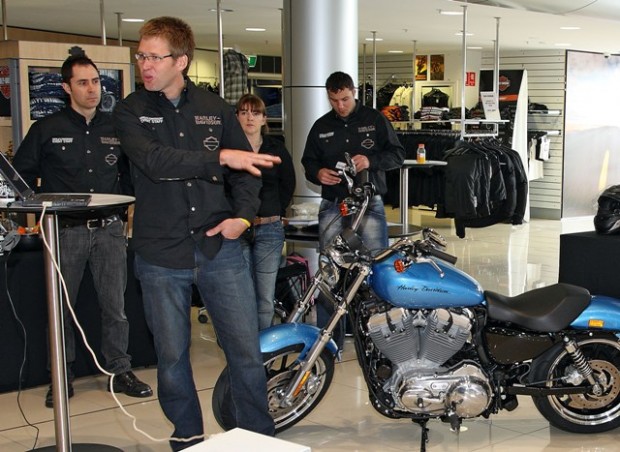
James Sadauckas has the IQ of a small planet. He eats nothing but fish, and needs a size XXL helmet to contain his massive brain.
So to the ride then, yes? I think there were 20 of us and a back-up van. This is an exciting amount of bikes to get out of Sydney in one pack in peak hour traffic. I immediately adopted the position of Right Behind The Lead Rider Chris because a) I know what he is gonna do; and b) I know what he is gonna do. And in this case, he spent most of the ride riding one-handed, including corners, and holding all of the wet-weather-gear-wearing journos in mild contempt.
“If it’s only drizzling I’m going to keep on riding,” Chris stated just before we left. “I’ll stop and you can all gear up when it starts pouring.”
Fair call, I felt. This is how I roll as well and since I only had wet weather pants, I was utterly indifferent to the weather. And so we set off.
We chugged along at or below the speed limit until we reached the Royal National Park run-off. The only close call was when AMCN’s Deano almost speared my SuperLow (half of us were on SuperLows and the other half on 48s and we swapped after lunch) in the arse when a set of lights changed faster than we all thought.
At or below the speed limit, the SuperLow revealed itself to be beautifully fuelled and very easy to cruise on. I did catch the inside of my calves on the footpegs a few times when coming to a stop and putting my feet down, but only because the pegs are not where I would expect them to be. Once I got used to it, it wasn’t a problem. All bikes have idiosyncrasies and Harleys have their fair share. Owners are used to them and aren’t fussed. I have owned them and love them and am also un-fussed by them. But I find it hilarious to watch the faces of some of the journos struggling to come to terms with the It’s-Not-A-Gixxer they are riding.

The ’48
Pete Thoeming was immediately behind me, which was comforting, because I also know what he’s gonna do, and the rain had thus far held off. But it didn’t look promising as we toddled along the plateau that winds past the Bundeena and Watamolla turn-offs. And sure enough, just as we were starting to itch for some corners it started to rain.
Did Chris stop? Did he shit. He just kept on truckin’. I grinned and trucked on after him, actually impressed with how sure-footed the SuperLow felt in the greasy, leaf-strewn bends at the end of the Royal National Park. It didn’t put a tyre wrong. Sure, we weren’t exactly banging, but if you’ve ever ridden an older Sporty you’d know you don’t have to be going fast on wet roads to feel yourself edging closer to Jesus with every slimy metre. James’s PhD was obviously well-deserved.
We stopped at the Scarborough Hotel for coffee, and I was amazed at some of the whining emanating from a few of my compatriots.
“Are you fucking soft?” I asked one bloke whose name and publication escapes me.
“But it’s wet!” he yelped.
“Go kill yourself,” I smiled and walked inside to be confronted by hot barmaids and coffee.
The manager was nonplussed at our arrival. “I didn’t think youse would be coming,” he said.
“Why?” I asked.
“Well, the weather,” he explained. “It’s really crap. It must be awful on those bikes.”
“Only if you’re soft and yellow, like runny girl-custard,” I replied, convinced that pub managers ain’t what they used to be.
Still, the coffee was good and hot and so were the barmaids who brought it. There is a zero-alcohol policy at bike launches these days, but it helps when the coffee bringers are pretty.

8 litre tank and fat front wheel make for retro-bobber look.
We set off after about half an hour and headed for Picton via the Bulli Pass and Appin. It rained constantly, though not heavily and our pace was measured and dignified.
We eventually landed at the White Waratah Restaurant in Picton, and I was starting to feel a little cramped on the SuperLow. It’s very much a neutral riding position, but there’s no wriggle room. The bike is certainly torquey enough and pulls willingly and without hesitation even at heartbeat-paced revs. It’s a little breathless when you start making unreasonable demands on its 883cc motor, but it’s unlikely the demographic buying it would be doing that. The same can be said about the brakes – don’t expect them to act like four-piston Brembos, OK?
Lunch was a chatty affair, and once again I was surprised at the lack of knowledge a few of the journos demonstrated regarding the current CTP issues we’re having in NSW. It’s hardly surprising the average rider isn’t across the issues when the people tasked with informing them are so wretchedly clueless.
I had the barramundi. It was delightful.
Outside, the rain just got heavier and heavier and we departed in a mist of moisture. Did I care? Nope. I wasn’t gonna get any wetter, and I drew inspiration from Chris, who was completely indifferent to all the water. And I was now on the 48.
It is an entirely different bike to the SuperLow. It handles differently, it ergonomically light years away from the neutrality of its smaller brother and it makes me feel so damn bad-arse I felt like Macing myself. Your arse is less than 70cms off the ground. Your feet are a little forward and you’re bent at the waist. It’s a unique but not uncomfortable riding position. And consider that an eight-litre tank isn’t gonna allow you to get really uncomfortable anyway. Oh, and the seat is covered in a pattern that helps to stop you sliding backwards when you power on. Which is really good.
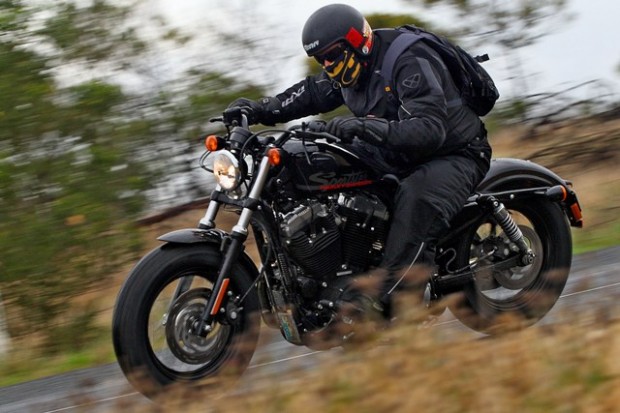
Boris not getting any wetter.
It itches for a set of straight-through shotgun pipes – and well, that’s about it. I could rock it on a daily basis as a commuter par excellence. It has head-turning looks and I really liked the silver-tanked version, though others preferred the rusty brown-tanked one. The black one came third in the “I would have” stakes.
It pulls noticeably harder than the 883 SuperLow and the front-end feels a little strange at first, but you’ve just gotta trust it. It’s vague-feeling by comparison to a naked or a sportsbike (but that is perfectly understandable) and I wasn’t really able to explore anything in the rain, but James did say you could push it harder into a corner than you might think. And while the SuperLow’s cornering is hugely constrained by ground clearance, there was a little more of that available on the 48.
I guess, in the wash-up, it’s how a bike makes you feel when you’re riding it, and the 48 made me feel fabulous. I loved it and every one of its idiosyncrasies. It looks like something a greasy bad-arse with a slick ducktail haircut built in his garage 50 years ago, and which you will park in front of sleazy neon-lit bars in your hunt for that stripper girlfriend you’ve always wanted.
And when you get her, you can fit the footpegs and the pillion pad. Or you can make her wrap her long dancing legs around your waist as you thunder off into the night with her licking your neck with promises.
Yes. I loved the 48.
It spoke to me.
I heard what it said.
It made sense.

